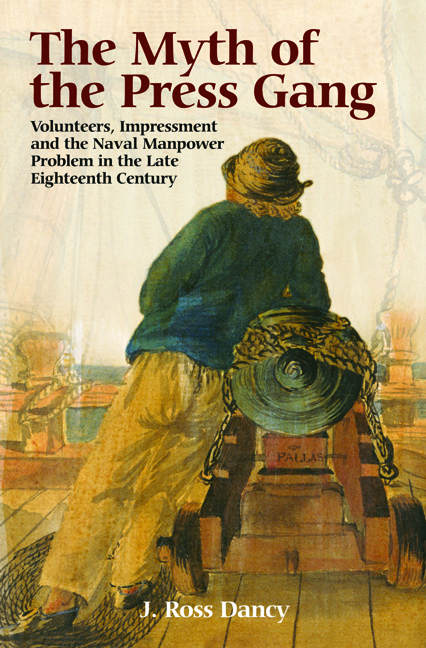 The Myth of the Press Gang
The Myth of the Press Gang Introduction
Published online by Cambridge University Press: 05 May 2015
Summary
‘Your Lordship is hereby required and directed to give immediate orders to the several Captains, Commanders and Commanding Officers of His Majesty's Ships and vessels under your command, not to enter or impress any more men for the Service of His Majesty's Fleet.’ The Admiralty sent this order to Lord Nelson on 10 October 1801. The Treaty of Amiens was being negotiated, peace was on the horizon and the Royal Navy was preparing for the inevitable downsizing that would come with peace. A few more months would see a temporary end to the hostilities that had raged for nearly a decade between Britain and France. However, during the previous nine years, the Royal Navy had grown from the small peacetime number of about 17,000 men to over 130,000 men, the largest navy ever assembled in the Atlantic world. This swell in manpower represented an increase of over 750 per cent. With 150 ships-of-the-line either in ordinary, repairing, or in sea pay in January of 1793, the Royal Navy had a force that could at least equal that of France and any other European nation. Therefore, with the declaration of war in 1793, the Royal Navy's principal problem was not constructing a naval force, but manning the fleet that Britain already had in existence.
Manning the Royal Navy was a problem of colossal proportions, and had grown increasingly throughout the eighteenth century as the Navy along with British sea trade expanded. This resulted in an ever-larger struggle for the scarce resource of skilled manpower, which made itself most evident during the initial mobilisation from peacetime to wartime footing. Recruiting seamen in the eighteenth century was essentially a problem of mathematics, pitting the requirements of the Navy against the population of mariners available to draw upon. Further, naval manning and mobilisation could not be allowed to destroy merchant sea trade through depriving it entirely of skilled manpower, and Britain simply did not have enough seamen to fully man the Royal Navy and the merchant fleets at the same time.
- Type
- Chapter
- Information
- The Myth of the Press GangVolunteers, Impressment and the Naval Manpower Problem in the Late Eighteenth Century, pp. 1 - 10Publisher: Boydell & BrewerPrint publication year: 2015
